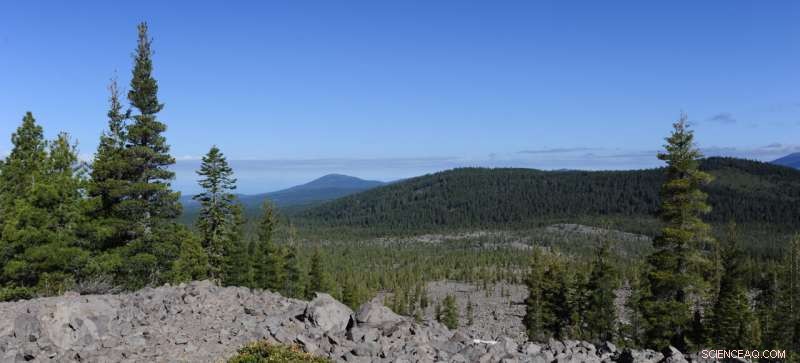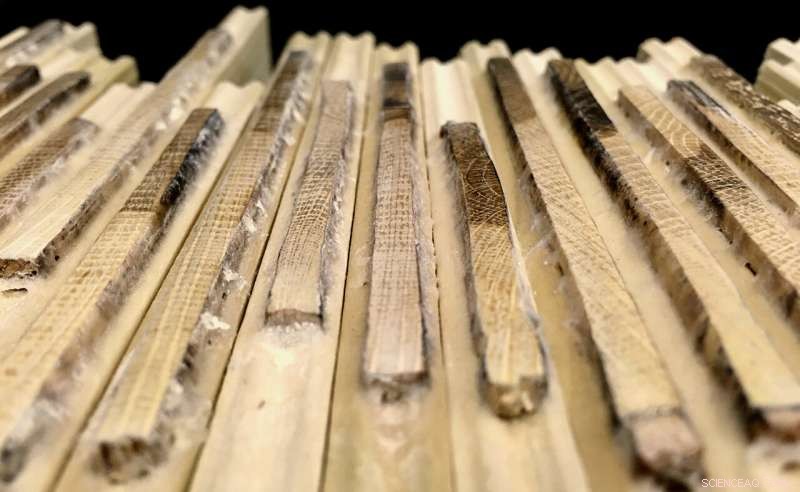
Un bosque de coníferas en el norte de California. Crédito:Antoine Cabon
¿Qué pasará con los bosques del mundo en un mundo que se calienta? ¿El aumento del dióxido de carbono atmosférico ayudará a que los árboles crezcan? ¿O las temperaturas extremas y las precipitaciones frenarán el crecimiento? Todo eso depende de si el crecimiento de los árboles está más limitado por la cantidad de fotosíntesis o por las condiciones ambientales que afectan el crecimiento de las células de los árboles, una pregunta fundamental en la biología de los árboles, y cuya respuesta no se entendía bien hasta ahora.
Un estudio dirigido por investigadores de la Universidad de Utah, con un equipo internacional de colaboradores, encuentra que el crecimiento de los árboles no parece estar generalmente limitado por la fotosíntesis, sino más bien por el crecimiento celular. Esto sugiere que debemos repensar la forma en que pronosticamos el crecimiento de los bosques en un clima cambiante, y que los bosques en el futuro tal vez no puedan absorber tanto carbono de la atmósfera como pensábamos.
"El crecimiento de un árbol es como un sistema de caballos y carretas que avanza por la carretera", dice William Anderegg, profesor asociado de la Facultad de Ciencias Biológicas de la U e investigador principal del estudio. "Pero básicamente no sabemos si la fotosíntesis es el caballo más frecuente o si se trata de la expansión y división celular. Esta ha sido una pregunta difícil y de larga data en el campo. Y es muy importante para comprender cómo responderán los árboles al cambio climático".
El estudio se publica en Science .
Fuente frente a sumidero
Aprendimos los conceptos básicos en la escuela primaria:los árboles producen su propio alimento a través de la fotosíntesis, tomando la luz solar, el dióxido de carbono y el agua y convirtiéndolos en hojas y madera.
Sin embargo, hay más en la historia. Para convertir el carbono obtenido de la fotosíntesis en madera, se requiere que las células de la madera se expandan y se dividan.
Entonces, los árboles obtienen carbono de la atmósfera a través de la fotosíntesis. Esta es la fuente de carbono de los árboles . Luego gastan ese carbono para construir nuevas células de madera, el sumidero de carbono del árbol. .

Núcleos de madera preparados para medir el ancho del anillo. Crédito:Antoine Cabon
Si el crecimiento de los árboles está limitado por la fuente, entonces está limitado solo por la cantidad de fotosíntesis que el árbol puede realizar y el crecimiento del árbol sería relativamente fácil de predecir en un modelo matemático. Entonces, el aumento del dióxido de carbono en la atmósfera debería aliviar esa limitación y permitir que los árboles crezcan más, ¿verdad?
Pero si, en cambio, el crecimiento de los árboles está limitado por el sumidero, entonces el árbol solo puede crecer tan rápido como sus células se pueden dividir. Muchos factores pueden afectar directamente tanto la fotosíntesis como la tasa de crecimiento celular, incluida la temperatura y la disponibilidad de agua o nutrientes. Entonces, si los árboles están limitados por el sumidero, la simulación de su crecimiento debe incluir la respuesta del sumidero a estos factores.
The researchers tested that question by comparing the trees' source and sink rates at sites in North America, Europe, Japan and Australia. Measuring carbon sink rates was relatively easy—the researchers just collected samples from trees that contained records of growth. "Extracting wood cores from tree stems and measuring the width of each ring on these cores essentially lets us reconstruct past tree growth," says Antoine Cabon, a postdoctoral scholar in the School of Biological Sciences and lead author of the study.
Measuring carbon sources is tougher, but doable. Source data was measured with 78 eddy covariance towers, 30 feet tall or more, that measure carbon dioxide concentrations and wind speeds in three dimensions at the top of forest canopies, Cabon says. "Based on these measurements and some other calculations," he says, "we can estimate the total forest photosynthesis of a forest stand."
Decoupled
The researchers analyzed the data they collected, looking for evidence that tree growth and photosynthesis were processes that are linked, or coupled. They didn't find it. When photosynthesis increased or decreased, there was not a parallel increase or decrease in tree growth.
"Strong coupling between photosynthesis and tree growth would be expected in the case where tree growth is source limited," Cabon says. "The fact that we mostly observe a decoupling is our principal argument to conclude that tree growth is not source-limited."
Surprisingly, the decoupling was seen in environments across the globe. Cabon says they did expect to see some decoupling in some places, but "we did not expect to see such a widespread pattern."

Detail of a wood core with visible growth rings (more recent rings towards the left) and bark on the right. Credit:Antoine Cabon
The strength of coupling or decoupling between two processes can lie on a spectrum, so the researchers were interested in what conditions led to stronger or weaker decoupling. Fruit-bearing and flowering trees, for example, exhibited different source-sink relationships than conifers. More diversity in a forest increased coupling. Dense, covered leaf canopies decreased it.
Finally, coupling between photosynthesis and growth increased in warm and wet conditions, with the opposite also true:that in cold and dry conditions, trees are more limited by cell growth.
Cabon says that this last finding suggests that the source vs. sink issue depends on the tree's environment and climate. "This means that climate change may reshape the distribution of source and sink limitations of the world forests," he says.
A new way to look forward
The key takeaway is that vegetation models, which use mathematical equations and plant characteristics to estimate future forest growth, may need to be updated. "Virtually all these models assume that tree growth is source limited," Cabon says.
For example, he says, current vegetation models predict that forests will thrive with higher atmospheric carbon dioxide. "The fact that tree growth is often sink limited means that for many forests this may not actually happen."
That has additional implications:forests currently absorb and store about a quarter of our current carbon dioxide emissions. If forest growth slows down, so do forests' ability to take in carbon, and their ability to slow climate change.